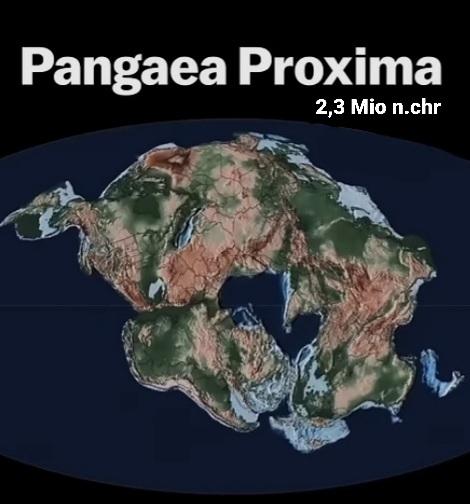Map of Pangea Proxima


Marcus Rodriguez
Historical Geography Expert
Marcus Rodriguez specializes in historical cartography and geographic data analysis. With a background in both history and geography, he brings unique...
Geographic Analysis
What This Map Shows
The "Map of Pangea Proxima" visualizes a speculative future supercontinent that is projected to form approximately 2.3 million years from now. This map illustrates the geophysical changes that our planet will undergo due to tectonic plate movements, which will lead to the reformation of landmasses. It is a fascinating glimpse into the Earth's geological future, showcasing a world where the continents we know today have shifted dramatically, combining into a single landmass once again.
Deep Dive into Plate Tectonics and Supercontinents
The concept of supercontinents is not new; throughout Earth’s history, we have seen the formation and breakup of several supercontinents, including the most famous one, Pangea, which existed around 335 million years ago. The formation of Pangea Proxima can be largely attributed to the ongoing movement of tectonic plates – massive slabs of the Earth’s lithosphere that float on the semi-fluid asthenosphere below.
Interestingly, the movement of these plates is caused by forces such as mantle convection, slab pull, and ridge push. Over millions of years, these forces will continue to drive the continents closer together, leading to the eventual amalgamation into Pangea Proxima.
What's fascinating is that the new supercontinent will have profound implications for global geography, climate, and biodiversity. For instance, as landmasses unite, they will likely create vast mountain ranges due to the collision of tectonic plates, akin to the Himalayas formed from the collision of the Indian subcontinent with Eurasia.
Furthermore, Pangea Proxima will impact ocean currents and atmospheric circulation patterns. The merging of continents will lead to changes in climate zones, as vast inland areas will be exposed to extreme weather conditions, resulting in harsher climates in the interior regions, while coastal areas might experience more temperate conditions. This shift could also alter ecosystems and habitats, leading to new evolutionary paths for flora and fauna.
Regional Analysis
Breaking down the projected regions of Pangea Proxima, we can see that areas that are currently known for their biodiversity, like the Amazon rainforest and Southeast Asian rainforests, might experience significant changes. The equatorial regions, which are currently rich in species diversity, may shift into different climatic zones, potentially leading to the extinction of some species while allowing others to thrive in new niches.
In contrast, the areas that will form the new supercontinent's central regions will likely become arid and less hospitable. For example, what is currently the Sahara Desert might expand further, as the continental landmasses shift and alter prevailing wind patterns.
Additionally, countries that are currently separated by vast oceans, such as Australia and Antarctica, will find themselves much closer together. This proximity could lead to increased interaction among species and the potential for new ecological dynamics. The geographical and ecological implications of such a shift are immense, and scientists are still uncovering the possible outcomes.
Significance and Impact
Understanding the formation of Pangea Proxima is crucial not only for geologists and geographers but for anyone interested in the long-term future of our planet. The potential for new ecological systems to emerge raises questions about conservation and biodiversity. As we contemplate the future, it’s essential to consider how current climate change could interact with these natural processes.
Moreover, the implications extend to human societies. As the landscape changes, so too will human settlements and the ways in which we interact with our environment. Urban planning, agriculture, and natural resource management will all need to adapt to the realities of a new supercontinent. The formation of Pangea Proxima may seem far-off, but it serves as a powerful reminder of the ever-changing nature of our planet and the importance of considering long-term environmental trends.
In conclusion, the "Map of Pangea Proxima" provides not just a visual representation of a possible future but also a valuable tool for understanding the dynamic processes that shape our world. As we learn more about plate tectonics and the shifting landscape of Earth, we gain insights that are crucial for sustainable development and environmental stewardship today and for generations to come.
Visualization Details
- Published
- October 8, 2025
- Views
- 38
Comments
Loading comments...